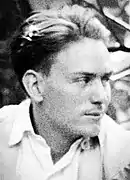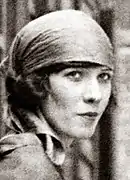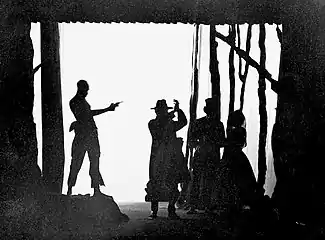Cleon Throckmorton
Cleon Francis "Throck" Throckmorton (born October 8, 1897, Absecon, New Jersey, died Atlantic City, New Jersey, October 23, 1965) was an American painter and theatrical designer, producer, and architect.[1][2][3] From 1919 into the early 1920s, Throckmorton ran the iconic Krazy Kat Klub in Washington, D.C., a Bohemian speakeasy and meeting place for artists and intellectuals.[2][3] He was posthumously inducted into the American Theater Hall of Fame in 2002.[4]
Cleon Throckmorton | |
|---|---|
 | |
| Born | October 8, 1897 Absecon, New Jersey, U.S. |
| Died | October 23, 1965 (aged 68) |
| Nationality | American |
| Education | Carnegie Institute of Technology George Washington University |
| Occupation | Theatrical designer |
Works | The Emperor Jones (1920) Porgy (1928) |
| Spouse(s) | Katherine "Kat" Mullen Juliet Brenon (m. 1927–1965) |
| Parents |
|
Early life
Born in Absecon, just outside Atlantic City, New Jersey, by 1912 Throckmorton's parents Ernest Upton Throckmorton and Roberta Cowing Throckmorton had moved to Washington, D.C. where Ernest ran a cigar store. Throckmorton attended the Carnegie Institute of Technology from 1917-18 and George Washington University from 1918-19 before starting a career as a painter. He studied painting with Charles Webster Hawthorne and Alexis Many.[5][1]
Theater work
In Provincetown, Throckmorton became involved with the experimental theater group the Provincetown Players. He designed and produced the sets for the first production of Eugene O'Neill's The Emperor Jones (1920) and a number of other works by the Players. Throckmorton went on to work on stage design or set design for over a hundred productions, including In Abraham's Bosom (1926; Pulitzer Prize, 1927), Porgy (1928), the American premiere of The Threepenny Opera (1933), Sidney Howard's Alien Corn (1933), the 1935 American premiere of Federico García Lorca's Blood Wedding (retitled as The Bitter Oleanders), and a 1942 production of Nathan the Wise.[6] In his heyday in the 1920s and early 1930s, it was said that the only person whose name appeared on more playbills than Throckmorton's was the fire commissioner.[7]
Many notable artists and stage designers worked with or for Throckmorton at the Provincetown Players, including Mordecai Gorelik,[8] Alexander Calder,[9] Robert Edmond Jones, and others.
From 1920-2, Throckmorton was associated with the drama department at Howard University, teaching and helping produce plays.

In 1928 Throckmorton and his friend writer Christopher Morley began to produce a series of revivals of old melodramas at theaters in Hoboken. They produced an assortment of works in association with it, including an illustrated map of Hoboken,[10] Hoboken passports,[11] and a book, "Born in a Beer Garden, or She Troupes to Conquer" (1930; written with an as-yet-unknown Ogden Nash). Later Throckmorton and Morley produced plays at the Millpond Playhouse in Roslyn, New York, including a well-received production of Morley's "The Trojan Horse".[1]
In 1934, Throckmorton's four concept drawings for the scene designs in The Emperor Jones were included in the 1934 International Exhibition of Theatre Art at the Museum of Modern Art.[12][13]
Throckmorton also became known as an architect and designer of theaters, working on the Cherry Lane Theatre in Greenwich Village, the Westport Country Playhouse, and others. In 1935 he was awarded a Guggenheim Fellowship in Theatre Arts to study classic European theaters.[6]
Throckmorton was posthumously inducted into the American Theater Hall of Fame in 2002.[4]
Later work
Throckmorton's theatrical work declined in the 1940s and he was forced to move on. He became an event planner, did murals for restaurants and nightclubs, and designed private homes. He also did pioneering television work designing simulations of historical events, battles, and other events that could not be filmed.[7]
Artwork
Drawings by Throckmorton still decorate the "Volare" restaurant in Greenwich Village in New York City, where they have been hanging since 1933.[14]
Marriages

Throckmorton's first wife was Katherine "Kat" Mullen.[2] A model and sketch artist, Mullen was a frequent habitué of Throckmorton's speakeasy known as "The Kat" in Washington, D.C., and was also known for her radio performances as a singer and ukulele player with the Crandall Saturday Nighters.[2][3] Throckmorton likely divorced Mullen when he permanently relocated from Washington, D.C. to New York City.
On March 13, 1927, Throckmorton married his second wife silent movie actress Juliet Brenon (1895-1979). The Brenons were a musical and theatrical family; her father Algernon had been a music critic, her uncle Herbert Brenon was a silent film director, and her sister Aileen (1894-1967) was a music critic and theatrical/film publicist whose husband was writer and art critic Thomas Craven.[15]
During the 1920s and 1930s, Throckmorton's Greenwich Village apartment that he shared with Juliet Brenon would become an after-hours salon for thespians, artists, and intellectuals such as Noël Coward, Norman Bel Geddes, Eugene O'Neill and E.E. Cummings.[1][16] Their politically leftward salon notably raised funds for the Republican faction during the Spanish Civil War.[1]
See also
References
Citations
| Wikimedia Commons has media related to Cleon Throckmorton. |
- The New York Times 1965.
- Flambeau 1922.
- The Evening Star 1925.
- Theater Hall of Fame 2002.
- The Washington Times 1921.
- Guggenheim Fellowship 1935.
- Somerset-Ward 2005, p. 35.
- Fletcher 2009, pp. 27-9.
- Perl 2017, pp. 174-178.
- Morley & Throckmorton 1929.
- Morley & Throckmorton 1930.
- Museum of Modern Art 1934, p. 63.
- Cleon Throckmorton: MoMA Entry 2019.
- McBurnie & Hammer 2015.
- Ditta 2018.
- The New York Times 1979.
Sources
- "Army-Navy Game To Be Broadcast: 'Saturday Nighters' Featured". The Evening Star. Washington, D.C. November 28, 1925. p. 38. Retrieved October 20, 2020 – via Newspapers.com.
...Katherine Throckmorton, songs with ukelele...
- Perl, Jed (October 24, 2017). Calder: The Conquest of Time: The Early Years: 1898-1940. Knopf Doubleday. ISBN 978-0-451-49421-4. Retrieved October 20, 2020.CS1 maint: ref=harv (link) CS1 maint: date and year (link)
- "Cleon Throckmorton: International Exhibition of Theatre Art (Jan 15–Feb 25, 1934)". Museum of Modern Art. 2019. Retrieved October 20, 2020.
- "Cleon Throckmorton, 68, Dead; Designed O'Neill Stage Settings". The New York Times. New York City. October 25, 1965. p. 37. Retrieved October 20, 2020.
- Ditta, Joseph (February 16, 2018). "Guide to the Aileen St. John-Brenon Papers (1920-1947 )". New-York Historical Society Museum & Library. Retrieved October 20, 2020.
Aileen's grandfather was the English dramatic critic Edward St. John-Brenon. Her uncle, Herbert Brenon (1880–1958), was a motion picture director perhaps best known for the silent films Peter Pan (1924) and Beau Geste (1926). Aileen's younger sister, Juliet St. John-Brenon (1895–1979), was an actress who appeared in some of their Uncle Herbert's films. Juliet married well-known set designer Cleon "Throck" Throckmorton (1897-1965), who maintained an active studio in bohemian Greenwich Village.
CS1 maint: ref=harv (link) - Flambeau, Victor (February 5, 1922). "Flambeau Finds Washington's Bohemia In Hidden Haunt Where Cleon Throckmorton Stages His First Exhibition" (PDF). The Washington Times (Sunday ed.). p. 7. Retrieved October 20, 2020 – via Library of Congress.CS1 maint: ref=harv (link)
- Fletcher, Anne (March 30, 2009). Rediscovering Mordecai Gorelik: Scene Design and the American Theatre. Southern Illinois University Press. ISBN 978-0-8093-2880-2. Retrieved October 20, 2020.CS1 maint: ref=harv (link)
- "Guggenheim Fellows Biography of Cleon Throckmorton". John Simon Guggenheim Memorial Foundation. Retrieved October 20, 2020.
- International Exhibition of Theatre Art (Jan 15–Feb 25, 1934) (PDF). Museum of Modern Art (Report). 1934. p. 63. Retrieved October 20, 2020.
- "Juliet B. Throckmorton". The New York Times. New York City. November 22, 1979. p. D13. Retrieved October 20, 2020.
- McBurnie, Karen; Hammer, Jon (July 9, 2015). "A Quick One at the Krazy Kat Klub". Grade A Fancy Magazine. Retrieved October 20, 2020.CS1 maint: ref=harv (link)
- Morley, Christopher; Throckmorton, Cleon (1929). "Bird's-eye View of Hoboken, New Jersey, U.S.A. New York's Last Seacoast of Bohemia. Issued 1929 by Christopher Morley et al". Hoboken Historical Museum. Retrieved October 20, 2020.CS1 maint: ref=harv (link)
- Morley, Christopher; Throckmorton, Cleon (February 3, 1930). "Passport. Hoboken Free State. Issued by Christopher Morley and Cleon Throckmorton. No. 51. Issued to J. Brooks Atkinson, February 3, 1930". Hoboken Historical Museum. Retrieved October 20, 2020.CS1 maint: ref=harv (link)
- Somerset-Ward, Richard (2005). An American Theatre: The Story of Westport Country Playhouse, 1931-2005. Yale University Press. p. 35. ISBN 978-0-300-10648-0. Retrieved October 20, 2020.CS1 maint: ref=harv (link)
- "Theater Hall of Fame: Cleon Throckmorton". American Theatre Critics Association. Archived from the original on 2010-05-17. Retrieved October 20, 2020.
- "Throckmorton Scenic Artist of Real Skill". The Washington Times (Sunday ed.). Washington, D.C. December 11, 1921. Retrieved October 20, 2020 – via Newspapers.com.
Cleon Throckmorton, well known Washingtonian and founder of the Crazy Kat Restaurant, is rapidly acquiring a reputation as a scene designer of parts through his association with the Provincetown Players of New York.

